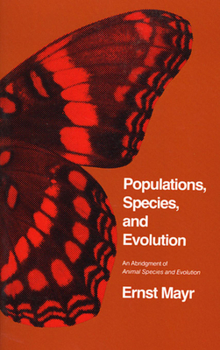Populations, Species, and Evolution: An Abridgment of Animal Species and Evolution
Select Format
Select Condition 
Book Overview
Representative of the international acclaim accorded Ernst Mayr's Animal Species and Evolution, published in 1963, is Sir Julian Huxley's description of it as "a magistral book...certainly the most important study of evolution that has appeared in many years--perhaps since the publication of On the Origin of Species." In his extraordinary book, Mayr fully explored, synthesized, and evaluated man's knowledge about the nature of animal...
Format:Paperback
Language:English
ISBN:0674690133
ISBN13:9780674690134
Release Date:January 1970
Publisher:Belknap Press
Length:453 Pages
Weight:1.40 lbs.
Dimensions:1.5" x 5.5" x 8.4"
Customer Reviews
2 ratings
AN ABRIDGEMENT OF AN EXCEPTIONAL WORK OF EVOLUTIONARY THEORY
Published by Thriftbooks.com User , 15 years ago
Ernst Mayr (1904-2005) was one of the leading evolutionary biologists, whose concept of speciation as a key to evolutionary development was critical for such persons as Stephen Jay Gould. This book is his own abridgement of Animal Species & Evolution. Mayr suggest that "Recombination makes far more new phenotypes available for selection than does mutation," and that "Recombination is by far the more important source of genetic variation, that is, of material for natural selection." He adds that "...comparatively high rates of phenotypically slight mutations actually do occur in most organisms." He does not dismiss Natural Selection (which he defines as "the differential perpetuation of genotypes"), but observes that "Natural selection is apparently defenseless against genotypes that are successful reproducers but do not add to the survival value of the species as a whole. This essential weakness of natural selection is a potential danger to every species, including mankind." He states that "If chance has any influence on the direction of evolution, it is that it `jars' it at frequent intervals and may occasionally be responsible for a jump to another track." However, "Changes of the phenotype are often saltational... The reorganization of the gene pool, required for successful speciation, is ... never saltational." He argues that "Each species is a biological experiment," and that "geographic speciation is the almost exclusive mode of speciation among animals, and most likely the prevailing mode even in plants," and further asserts that "population if ultimately the key to every evolutionary problem and ... any evolutionary theory which overlooks the importance of populations is doomed to failure." Mayr also firmly rejects supposed conclusions drawn from supposed correlations between race and intelligence. "Every individual must, therefore, be treated on the basis of his own characteristics, never those of his race." This is a major work by a prominent and influential evolutionary theorist.
Absolutely Wonderful Introduction to Evolutionary Biology
Published by Thriftbooks.com User , 16 years ago
I cannot praise this book highly enough. It is slightly outdated, of course, since it was originally published in 1970. For example, you should ignore the entire last chapter (on human evolutionary history), and Mayr is incorrect about the evolutionary history of human head and body lice, but the basic ideas of the book still apply today. This book is great because Mayr is a master of laying out comlex material straightforwardly, interestingly, in a well-organized fashion, and with lots of helpful illustrations. Mayr talks about how variation in traits is maintained in animal populations(mutation, sexual recombination), how variation is lost (natural selection, genetic drift), and also talks about genetic mechanisms which tend to shield genetic variation from being lost. He talks a lot also about biogeography and populations, clines and isophenes (this last word was a new one on me). As one might expect from one of the architects of the modern synthesis, his explanation of the relationship between genetics and the origin of novel species is a miracle of clarity. Again: I cannot recommend this book highly enough. This book is especially nice because it bridges the gap between the modern evolutionary synthesis of the '30s and '40s and what came after. Mayr wrote this at a time when people were just beginning to realize how regulatory genes work, and what their evolutionary importance might be. This book represents the midway point between work by Dobzhansky and the population geneticists in the '30s and '40s and the birth of evolutionary developmental biology (evo-devo) in the '80s and '90s. I have only two problems with the book. First, the last chapter is garbage by today's standards. Those parts of it which have not been superseded by more recent scientific work are facile arguments which are out of place in a book of this nature. Mayr argues vehemently, for example, that human overbreeding should be seen as every bit as morally reprehensible as murder. My second problem is that the book is a bit outdated--something for which Mayr cannot be faulted. You might want to follow it up with something more recent, maybe something by Douglas Futuyma. Mayr's book is so well-written, well-illustrated, well-organized, and informative, however, that I must still give it five stars in spite of these problems. A word of warning: this is not a beach read. It is an abridgement of one of Mayr's earlier works, but it is still a bit technical, and thus should not be the first book you ever read about the theory of evolution. If you understand how DNA transcription and translation work, however, and you know the basic ideas about natural selection and speciation, and have taken at least one or two college-level biology classes, you should be fine. You will definitely find yourself using the glossary. Buy it, read it, kiss it, cook it dinner. This book is spectacular.





